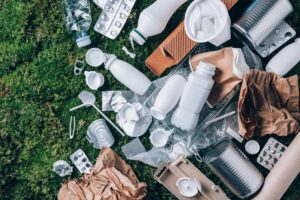

A new study suggests ways to improve the effectiveness of water harvesting, specifically in relation to the condensation of water from collected droplets.
The work focuses on addressing water scarcity by exploring atmospheric water harvesting. The water in the air originates from both natural and forced evaporation, with condensation being the final and crucial step in water harvesting. Condensation involves nucleation, growth, and shedding of water droplets, which are then collected. However, uncontrollable growth of condensed droplets leading to surface flooding is a pressing challenge, posing a threat to sustainable condensation.
To expedite this process and achieve orderly and rapid droplet shedding from the condensing surface, the team – Tsinghua University – took inspiration from nature. They observed that the Australian thorny devil – a species of lizard – efficiently spread droplets, such as rains, dews, and pond water, from its scales to capillary channels between the scales, eventually connecting to its mouth. This natural mechanism made water easier to store and consume. Additionally, the team drew inspiration from fish, particularly catfish, which possess an epidermal mucus layer reducing swimming drag and enhancing adaptability to aqueous environments. These insights from nature address the challenges of orderly droplet navigation and low-drag droplet shedding, respectively.
The research team employed hydrogel fibres to create an engineered pattern on glass, incorporating the advantageous features of both lizards and catfish. The hydrogel fiber is an interpenetrated network of sodium alginate and polyvinyl alcohol with a partially polymerized surface and arch structure. The surface, adorned with branched –OH and –COOH chains, exhibits a strong affinity for water molecules. This affinity, coupled with the arch structure, provides sufficient driving force for droplets to move from the condensing substrate to the hydrogel fiber. Simultaneously, the branched –OH and –COOH chains can retain water molecules even after droplets leave the surface, aiding in the formation of a precursor water film that lubricates droplet sliding.
To observe droplet movement, fluorescent molecules were utilized as probes. The captured trajectories revealed an impressive migration rate, with droplets formed on the glass swiftly pumped to the hydrogel fiber, thereby regenerating the condensing sites. The success lies in the concurrent application of chemical wetting gradients and the Laplace pressure difference across the hydrogel fiber and the glass. The pumping effect resulted in a reduction of over 40% in the energy of the droplet-condensing surface system, acting as the driving force source. “This is similar to the directional water dispersion over the integuments of lizards” , Professor Qu notes.
The researchers also observed distinctions in the movement of water on the hydrogel fiber surface compared to that on glass. On the glass, droplets advanced as a cohesive unit with successive formation of new advancing angles, resulting in complete mixing of fluorescent probes within the droplet during advancement. In contrast, droplet sliding on the hydrogel fiber surface exhibited a layered behavior. The inner layer of water bonded to the hydrogel surface, while the outer layer slid without direct contact with the hydrogel surface. “The dangling chains over the hydrogel surface act like the mucus layer of the catfish, lubricating the friction between the droplets and the condensing surface,” explains Dr. Ji.
This engineered hydrogel fiber pattern increased the condensation rate by 85.9% without requiring external energy input. Moreover, it was successfully applied to enhance the water collection rate of solar evaporative water purification by 109%. This study not only provided insights into natural phenomena but also marked a novel attempt to manipulate droplet movement for condensation. The findings lay the foundation for future endeavors in discovering phenomena and translating theories into practical applications.
- SEO Powered Content & PR Distribution. Get Amplified Today.
- PlatoData.Network Vertical Generative Ai. Empower Yourself. Access Here.
- PlatoAiStream. Web3 Intelligence. Knowledge Amplified. Access Here.
- PlatoESG. Carbon, CleanTech, Energy, Environment, Solar, Waste Management. Access Here.
- PlatoHealth. Biotech and Clinical Trials Intelligence. Access Here.
- Source: https://envirotecmagazine.com/2024/01/31/bioinspired-hydrogel-patterning-offers-more-effective-ways-to-harvest-water/
- :is
- :not
- a
- Achieve
- across
- Act
- acting
- Additionally
- address
- addressing
- advanced
- advancement
- advancing
- advantageous
- affinity
- After
- AIR
- Alcohol
- also
- an
- and
- Application
- applications
- applied
- ARE
- AS
- atmospheric
- attempt
- Australian
- banners
- behavior
- being
- between
- bonded
- both
- but
- by
- CAN
- captured
- chains
- challenge
- challenges
- channels
- chemical
- China
- cohesive
- collect
- collection
- compared
- complete
- concurrent
- Connecting
- consume
- contact
- content
- contrast
- could
- coupled
- covered
- create
- credit
- crucial
- devil
- difference
- direct
- directional
- disabled
- discovering
- Dispersion
- dr
- driving
- during
- easier
- effect
- Effective
- effectiveness
- efficiently
- either
- employed
- endeavors
- energy
- engineered
- enhance
- enhancing
- environments
- Envirotec
- Even
- eventually
- exhibited
- Exhibiting
- exhibits
- expedite
- Explains
- Exploring
- external
- Features
- Film
- final
- findings
- Fish
- focuses
- For
- Force
- forced
- form
- formation
- formed
- Foundation
- friction
- from
- future
- glass
- gradients
- great
- Growth
- harvest
- Harvesting
- High
- However
- HTTPS
- hydration
- image
- impressive
- improve
- in
- incorporating
- increased
- inner
- input
- insights
- Inspiration
- into
- involves
- IT
- ITS
- jpg
- lay
- layer
- layered
- leading
- Leave
- lies
- like
- made
- make
- marked
- mechanism
- migration
- Mixing
- more
- Moreover
- mouth
- move
- movement
- mucus
- Natural
- Nature
- Navigation
- network
- New
- no
- None
- Notes
- novel
- observe
- observed
- of
- Offers
- on
- only
- or
- over
- particularly
- Pattern
- plato
- Plato Data Intelligence
- PlatoData
- POND
- possess
- Practical
- Practical Applications
- precursor
- press
- pressing
- pressure
- process
- Professor
- provided
- provides
- pumping
- qualified
- Quick
- rapid
- Rate
- reducing
- reduction
- relation
- research
- researchers
- respectively
- resulted
- resulting
- retain
- Revealed
- scales
- Scarcity
- shedding
- similar
- simultaneously
- Sites
- Skin
- sliding
- smooth
- sodium
- solar
- Source
- specifically
- spread
- Step
- store
- strong
- structure
- Study
- substrate
- success
- Successfully
- such
- sufficient
- Suggests
- Surface
- sustainable
- swiftly
- swimming
- system
- team
- that
- The
- their
- then
- There.
- thereby
- These
- they
- this
- threat
- to
- took
- toward
- Tsinghua
- uncontrollable
- unit
- university
- utilized
- was
- Water
- ways
- were
- which
- while
- with
- within
- without
- Work
- zephyrnet







